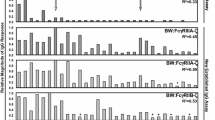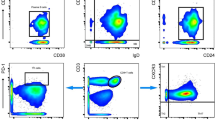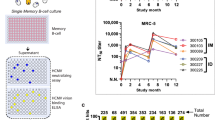Abstract
To assess whether a different IgG subclass distribution was elicited in “low” and “high responders” after vaccination with recombinant hepatitis B virus surface antigen, we selected from 360 vaccine recipients 30 “lowresponder” subjects, with anti-HBs levels of 10–160 mIU/ml, and 40 “high-responder” subjects, with anti-HBs levels greater than 10,000 mIU/ml. In both groups all IgG subclasses were elicited in the anti-HBs response and the greatest contribution was that of IgG 1, followed by IgG2. IgG l was significantly less represented after the second (58%) and third doses (61%) of vaccine in “low responders” compared with “high responders” (65% and 69%). The relative percentage of IgG2 was significantly higher after the second (33%) and third (30%) doses of vaccine in “low responders” than in “high responders” (29% and 26%). In “low responders” the age of vaccine recipients significantly influenced the anti-HBs IgG subclass distribution: IgG2 and IgG4 production was positively correlated with age, whereas the opposite was observed for IgGl. These data support the evidence that: (1) IgGl and IgG2 subclasses are mainly involved in the specific anti-HBs response both in “high” and “low responders”; (2) the relative contribution of specific IgG2 to vaccination is higher in low responders and progressively increases with age.
Similar content being viewed by others
References
Hamilton RG. Properties of the human IgG subclasses. In: The human IgG subclasses. La Jolla, California: Calbiochem; 1989: pp 5–107
Shakib F. Basic and clinical aspects of human IgG subclasses. Monogr Allergy 1986; 19:1.
Falconer AE, Carson R, Johnstone R, Bird P, Kehoe M, Calvert JE. Distinct IgG l and IgG3 subclass responses to two streptococcal protein antigens in man: analysis of antibodies to streptolysin O and M protein using standardized subclass-specific enzyme-linked immunosorbent assays. Immunology 1993; 79:89.
Yount WJ, Dorner MM, Kunkel HG, Kabat EA. Studies on human antibodies. VI. Selective variations in subgroup composition and genetic markers. J Exp Med 1968; 127:633.
Kaniuk AS, Lortan JE, Monteil MA. Specific IgG subclass antibody levels and phagocytosis of serotype 14 pneumococcus following immunization. Scand J Immunol 1992; 36 Suppl 11:96.
Elovaara I, Albert PS, Ranki A, Krohn K, SeppÄlÄ I. HIV-1 specificity of cerebrospinal fluid and serum IgG, IgM, and IgG 1-G4 antibodies in relation to clinical disease. J Neurol Sci 1993; 117:111.
Urban M, Winkler T, Landini MP, Britt W, Mach M. Epitopespecific distribution of IgG subclasses against antigenic domains on glycoproteins of human cytomegalovirus. J Infect Dis 1994; 169:83.
SÄllberg M, Norder H, Lindh G, Magnius LO. IgG subclasses in circulating immune complexes with hepatitis B e antigen in chronic hepatitis B. Clin Exp Immunol 1991; 84:116.
Akbar SMF, Horiike N, Onji M, Ohta Y. Immunoglobulin G subclasses of antibodies to hepatitis B core antigen in HBs antigen positive liver diseases. J Gastroenterol Hepatol 1991; 6:71.
Rath S, Devey ME. IgG subclass composition of antibodies to HBsAg in circulating immune complexes from patients with hepatitis B virus infections. Clin Exp Immunol 1988; 72:164.
Persson MAA, Brown SE, Steward MW, et al. IgG subclassassociated affinity differences of specific antibodies in humans. J Immunol 1988; 140:3875.
Mattila PS, Pelkonen J, MÄkelÄ O. Proportions of IgG subclasses in antibodies formed during vaccination with hepatitis B surface antigen. Scand J Immunol 1986; 24:699.
Rossi ME, Azzari C, Resti M, Appendino C, Pezzati P, Vierucci A. Selectivity in IgG subclass response to hepatitis B vaccine in infants born to HBsAg-positive mothers. Clin Exp Immunol 1988; 72:196.
Jilg W, Lorbeer B, Schmidt M, Wilske B, Zoulek G. Deinhardt F. Clinical evaluation of a recombinant hepatitis B vaccine. Lancet 1984; II: 1174.
Andrè FE, Safary A. Clinical experience with a yeast-derived hepatitis B vaccine. In: Zuckerman AJ, ed. Viral hepatitis and liver disease. New York: Liss; 1988:1025–1030.
Jilg W, Deinhardt F. Results of immunization with a recombinant yeast-derived hepatitis B vaccine. J Infect 1986; 13 Suppl A:47.
Hollinger FB, Adam E, Heiberg D, Melnick JL. Response to hepatitis B vaccine in a young adult population. In: Szmuness W, Alter HJ, Maynard JE, eds. Viral hepatitis. Philadelphia: Franklin Institute; 1982:451–456.
BorzÌ RM, Dal Monte P, Honorati MC, Facchini A. IgG subclass distribution of anti-HBs antibodies following vaccination with cDNA HBsAg. J Immunol Methods 1992; 146:17.
Barnaba V, Franco A, Paroli M, et al. Selective expansion of cytotoxic T lymphocytes with a CD4+CD56+ surface phenotype and a T helper type 1 profile of cytokine secretion in the liver of patients chronically infected with hepatitis B virus. J Immunol 1994; 152:3074.
Soiffer RJ, Murray C, Ritz J, et al. Recombinant interleukin-2 infusions and decreased IsG2 subclass concentrations. Blood 1995; 85:925.
Gillis S, Kozak R, Durante M, Weksler ME. Immunological studies of ageing. Decreased production of and response to T cell growth factor by lymphocytes from aged humans. J Clin Invest 1981; 67:937.
Jackola DR, Ruger JK, Miller RA. Age-associated changes in human T cell phenotype and function. Aging Clin Exp Res 1993 ; 6:25.
Paganelli R, Scala E, Quinti I, Ansotegui IJ. Humoral immunity in aging. Aging Clin Exp Res 1994; 6:143.
Hsu HY, Chang MH, Ho HN, et al. Association of HLA-DR14-DR52 with low responsiveness to hepatitis B vaccine in Chinese resident in Taiwan. Vaccine 1993; 11:1437.
Craven DE, Awdeh ZL, Kunches LM, Yunis EJ, Dienstag JL, Werner BG. Nonresponsiveness to hepatitis B vaccine in health care workers: results of revaccination and genetic typings. Ann Intern Med 1986; 105:356.
Alper CA, Kruskall MS, Marcus-Bagley D, et al. Genetic prediction of nonresponse to hepatitis B vaccine. N Engl J Med 1989; 321:708.
Author information
Authors and Affiliations
Rights and permissions
About this article
Cite this article
Honorati, M.C., Borzì, R.M., Dolzani, P. et al. Distribution of IgG subclasses after anti-hepatitis B virus immunization with a recombinant vaccine. Int J Clin Lab Res 27, 202–206 (1997). https://doi.org/10.1007/BF02912459
Received:
Accepted:
Issue Date:
DOI: https://doi.org/10.1007/BF02912459




